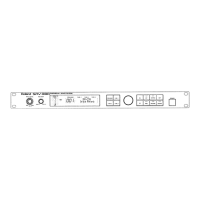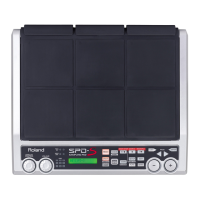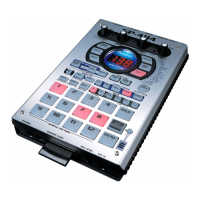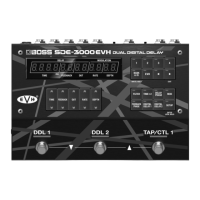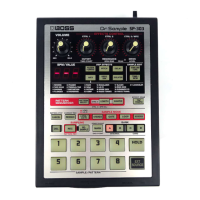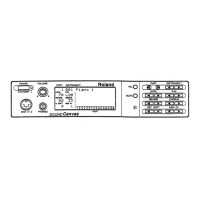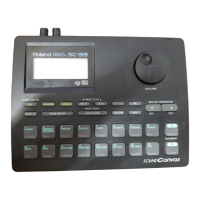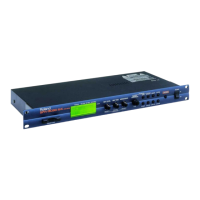
Do you have a question about the Roland SRV-3030 and is the answer not in the manual?
| Type | Digital Reverb |
|---|---|
| Channels | Stereo |
| Frequency Response | 20 Hz - 20 kHz |
| Dynamic Range | 90 dB |
| Sampling Frequency | 44.1 kHz |
| Bit Depth/A/D Conversion/D/A Conversion | 16-bit |
| THD+N | 0.05% |
| Reverb Types | Hall, Room, Plate |
| Inputs | 2 x 1/4" TRS |
| Outputs | 2 x 1/4" TRS |
| MIDI | In/Out |
| Power Supply | AC Adapter |
| Dimensions | 482 (W) x 44 (H) x 280 (D) mm / 19 (W) x 1-3/4 (H) x 11-1/16 (D) inches |
Explains manual's text conventions for buttons and references.
Emphasizes the need to retain safety instructions for future reference.
Clarifies the meaning of WARNING/CAUTION and safety symbols.
Lists essential operational safety guidelines to follow.
Summarizes primary features like sound quality, reverb units, and editing methods.
Covers power supply, placement, maintenance, and general handling advice.
Identifies and describes the front panel layout.
Identifies and describes the rear panel connections.
Procedure to reset the unit to its original factory state.
How to audition built-in demo and preview sounds.
Adjusting reverb sounds and resolving common issues.
Guides on connecting the unit to audio sources and devices.
Details on connecting mixers and instruments.
Instructions for connecting external control devices.
Correct power-on sequence and setting input/output levels.
Adjusting volume and selecting programs by number/bank.
Using categories to efficiently find desired programs.
Using the preview function and setting reverb volume.
Modifying reverb decay and sonic characteristics.
Engaging bypass and optimizing display readability.
Concepts like programs, display, and unit structure for sound design.
Quick sound adjustments using parameter sets for tone images.
Precise editing of reverb and effect parameters.
Mapping parameters to the unit's control knobs.
Details on parameter assignment, unit linking, and value ranges.
Assigning external controllers for real-time parameter control.
Choosing controllers and customizing program names.
Saving created programs to the unit's internal memory.
Storing programs on cards and copying between cards/unit.
Transferring data between memory cards.
Proper insertion and preparation of memory cards.
Using write protect seals to safeguard data.
Switching between Pattern and Structure display modes.
Using foot switches for reverb bypass and preview playback.
Recording custom sounds for previewing effect settings.
Basic MIDI concepts, types of messages, and connectors.
Overview of MIDI messages and controlling programs externally.
Customizing MIDI program change message correspondence.
Transmitting unit settings via MIDI.
Loading settings into the unit via MIDI.
List of parameters adjustable via the EZ EDIT function.
Detailed explanations of EZ EDIT parameters.
Comprehensive list of custom parameters with display values.
Further details on custom parameters.
Detailed parameters for Gate Reverb and Ambience effects.
Parameters for Non-Linear Reverb and the 3-band EQ.
Parameters for modulation effects and program naming/preview.
Assigning parameters to knobs and external controllers.
Explains reverb structure, types, and mix balance.
Details on routing effects and using the dynamic separator.
In-depth functions of the Dynamic Separator.
Detailed parameters for natural reverb sounds.
Parameters for density, reverb propagation, and compression.
Parameters for early reflections, including TAP editing.
Detailed parameters specific to the Gate Reverb effect.
Parameters for low and high-frequency damping.
Detailed parameters for the Ambience effect.
Detailed parameters for the Non-Linear Reverb effect.
Parameters for envelope shaping and the equalizer.
Parameters related to effects and high-band EQ.
Parameters for Separation, Manual, Resonance, LFO Rate, and Depth.
Settings for program names, categories, and preview sounds.
Preview tone/pattern settings and assigning parameters to knobs.
Assigning external controllers and understanding dynamic control.
Guidance on routing RSS effects within the signal path.
A comprehensive list of system parameters and their values.
Detailed explanation of each system parameter's function.
Explains how MIDI Control Change messages control functions.
Lists parameters for saving programs and memory cards.
Explains memory-related functions like program write and card format.
Selecting the master clock for digital synchronization.
Guidelines for connecting digital audio equipment.
Details on digital formats, channel status, and technical specs.
Solutions for no sound, low sound, or distorted audio.
Troubleshooting program switching and MIDI communication.
Explanations for error messages and how to resolve them.
